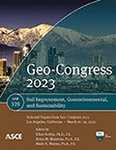Non-Contact Measurement of Vertical Deflections of Rail Trackbeds and Performance Testing of Stabilized Sub-Ballasts Using a Novel Micropiling System
Publication: Geo-Congress 2023
ABSTRACT
Trackbed stabilization (TBS) refers to engineering works to improve the railway trackbed stiffness in areas affected by poor load bearing capacity from soft subgrade. There are a variety of TBS techniques available to improve soft subgrades; however, many conventional approaches require a full renewal of the ballast which is disruptive and requires lengthy track possession time. This paper documents the improvements of a soft subgrade site in the UK using micropiles, installed between sleepers during overnight possession methods, thus allowing daytime rail traffic to run as normal. A non-contact vision-based monitoring (VBM) system developed by the authors and consisting of a high-speed camera was used to quantify the track bed deflection before and after the remedial works. The VBM system records displacement–time response of the rail and its foundation system during train passage. The results obtained from the experiments indicate that the post-rehabilitation trackbed modulus was increased.
Get full access to this article
View all available purchase options and get full access to this chapter.
REFERENCES
Aingaran, S., Le Pen, L., Zervos, A., and Powrie, W. (2018). Modelling the effects of trafficking and tamping on scaled railway ballast in triaxial tests. Transportation Geotechnics, 15, 84–90.
Bowness, D., Lock, A., Powrie, W., Priest, J., and Richards, D. (2007). Monitoring the dynamic displacements of railway track. Proceedings of the Institution of Mechanical Engineers, Part F: Journal of Rail and Rapid Transit, 221(1), 13–22.
Brownjohn, J. M. W., Xu, Y., and Hester, D. (2017). Vision-based bridge deformation monitoring. Frontiers in Built Environment, 3, 23.
Kayes, I., Nissen, D., and Adamson, J. (2000). Stabilisation of rail track formation and embankments. Paper presented at the CORE 2000, Railway Technology for the 21st Century, Conference on Railway Engineering, Glenelg, South Australia, May 21-23, 2000.
Kromanis, R., and Kripakaran, P. (2021). A multiple camera position approach for accurate displacement measurement using computer vision. Journal of Civil Structural Health Monitoring, 11(3), 661–678.
Liu, X., Saat, M. R., and Barkan, C. P. (2012). Analysis of causes of major train derailment and their effect on accident rates. Transportation Research Record, 2289(1), 154–163.
Milne, D., Le Pen, L., Watson, G., Thompson, D., Powrie, W., Hayward, M., and Morley, S. (2018). Monitoring and repair of isolated trackbed defects on a ballasted railway. Transportation Geotechnics, 17, 61–68.
Milne, D., Pen, L. L., Thompson, D., and Powrie, W. (2018). Automated processing of railway track deflection signals obtained from velocity and acceleration measurements. Proceedings of the Institution of Mechanical Engineers, Part F: Journal of Rail and Rapid Transit, 232(8), 2097–2110.
Murray, C. A., Take, W. A., and Hoult, N. A. (2015). Measurement of vertical and longitudinal rail displacements using digital image correlation. Canadian Geotechnical Journal, 52(2), 141–155.
Ngo, N. T., Indraratna, B., and Rujikiatkamjorn, C. (2017). Stabilization of track substructure with geo-inclusions—experimental evidence and DEM simulation. International Journal of Rail Transportation, 5(2), 63–86.
Nielsen, J. C., Berggren, E. G., Hammar, A., Jansson, F., and Bolmsvik, R. (2020). Degradation of railway track geometry–Correlation between track stiffness gradient and differential settlement. Proceedings of the Institution of Mechanical Engineers, Part F: Journal of Rail and Rapid Transit, 234(1), 108–119.
Prakoso, P. B. (2017). Analysis and Evaluation of Railway Track Systems on Soft Soil: Trackbed Thickness Design and Dynamic Track-Soil Interaction. Technische Universität München.
Pye, N., O’Brien, A., Essler, R., and Adams, D. (2012). Deep dry soil mixing to stabilize a live railway embankment across Thrandeston Bog Grouting and Deep Mixing 2012 (pp. 543–553).
Raymond, G. P. (1985). Analysis of track support and determination of track modulus. Transportation Research Record, 1022, 80–90.
Selig, E. T., and Li, D. (1994). Track modulus: Its meaning and factors influencing it. Transportation Research Record, 1470, 47–54.
Wheeler, L. N., Take, W. A., and Hoult, N. A. (2017). Performance assessment of peat rail subgrade before and after mass stabilization. Canadian Geotechnical Journal, 54(5), 674–689.
Zhou, S., Wang, B., and Shan, Y. (2020). Review of research on high-speed railway subgrade settlement in soft soil area. Railway Engineering Science, 28(2), 129–145.
Information & Authors
Information
Published In
History
Published online: Mar 23, 2023
Authors
Metrics & Citations
Metrics
Citations
Download citation
If you have the appropriate software installed, you can download article citation data to the citation manager of your choice. Simply select your manager software from the list below and click Download.
